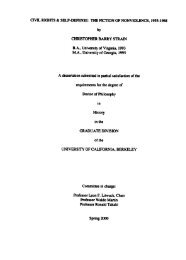Negro Digest - Freedom Archives
Negro Digest - Freedom Archives
Negro Digest - Freedom Archives
Create successful ePaper yourself
Turn your PDF publications into a flip-book with our unique Google optimized e-Paper software.
lacks are better off, but we must<br />
ask, better off in relation to what?<br />
Are they better off in relation to<br />
their previous situation, in relation<br />
to low-income blacks or in relation<br />
to whites in the same areas in which<br />
they live?<br />
Some limited data from Cleveland<br />
provide us with some tentative<br />
answers to what may be happening<br />
to black people in various parts<br />
of the large cities of the nation .<br />
While most of Cleveland's black<br />
population is generally found in<br />
nine neighborhoods, some black<br />
people live outside of these areas .<br />
In 1960, some 8 .9 percent of the<br />
black people in Cleveland lived outside<br />
of the black community area ;<br />
and in 1965, 15 .0 percent of the<br />
black people lived outside of this<br />
area . If we assume that, in general,<br />
those living away from the black<br />
community are middle-income people,<br />
and those within the community<br />
low-income blacks, we can compare<br />
some of the characteristics of<br />
these two groups of blacks, and<br />
then compare them to middle-income<br />
whites in Cleveland . The<br />
table lists some of the social and<br />
economic characteristics of these<br />
three groups in Cleveland for 1960<br />
and 1965 .<br />
In 1960, middle-income black<br />
people had a fertility ratio (the<br />
number of children under five for<br />
every 1,000 women aged 15-49 )<br />
much lower than that of low-income<br />
blacks, indicating that poor<br />
blacks had more children to care<br />
for and less money with which to<br />
NEGRO DIGEST March 1968<br />
do so than their more prosperous<br />
brothers . The proportion of children<br />
under 18 living with both parents<br />
gives some indication of family<br />
"stability," and here the middleincome<br />
blacks were also better off<br />
for a higher percentage of their<br />
children live in "stable" families .<br />
Furthermore, middle-income blacks<br />
had a full year more of completed<br />
school than did those in low-income<br />
areas .<br />
Although middle-income blacks<br />
have an employment rate lower<br />
than that of low-income blacks,<br />
both groups have high levels of employment<br />
. The difference between<br />
the two groups is most clearly seen<br />
in the income statistics . Middleincome<br />
blacks have a much lower<br />
proportion of families and the very<br />
low income category, and a higher<br />
proportion in the category of those<br />
families making from eight to fifteen<br />
thousand dollars per year .<br />
Therefore, the median income of<br />
the poor black families was only 86<br />
percent as much as the median income<br />
of the black families living<br />
outside of the black community .<br />
We can confidently say that in<br />
Cleveland in 1960 middle-income<br />
blacks were better off than lowincome<br />
blacks .<br />
By 1965, the fertility ratio for<br />
all black families had dec~ined considerably,<br />
but the middle-income<br />
blacks still had much lower fertility<br />
than low-income blacks . The<br />
proportion of "stable" families in<br />
two communities went in opposite<br />
directions ; it got worse for tire low-<br />
s~
















